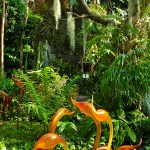Plant biology
Plant Biologist Eloy Rodriguez came from humble beginnings and now is a leading authority on ethnobotanical medicine.
Eloy Rodriguez is an expert of ethnobotanical medicine (the benefits of natural plants to healing and disease prevention). He coined the concept and study of zoopharmacognosy, the process by which non-human animals(such as apes) self-medicate by selecting and using plants to treat and prevent disease.
Cited in books and passed down for centuries, plants have been used for ages by many ethnic cultures to treat infections, cancer, diabetes, malaria and other illnesses. "…
This one-liner from the 1967 classic "The Graduate" might have made Benjamin Braddock (Dustin Hoffman) cringe:
But 43 years later, it's obvious that Mr. McQuire was onto something. Today, it's hard to imagine life without plastic, from brushing your teeth in the morning to pouring yourself a glass of milk. We produce so much of the stuff, though, that we now face major environmental problems. Conventional plastic is made from crude oil, is not often recycled, and, when put in landfills, can release toxins that enter soil, water, and the food chain.
Researchers at Brookhaven and Dow…
One of my hobbies lately has been to get either RNA seq or microarray data from GEO and do quick analyses. Not only is this fun, I can find good examples to use for teaching biology.
One of these fun examples comes from some Arabidopsis data. In this experiment, some poor little seedlings were taken out of their happy semi-liquid culture tubes and allowed to dry out. This simulated drought situation isn't exactly dust bowls and hollow-eyed farmers, but the plants don't know that and most likely respond in a similar way.
We can get a quick idea of how the plants feel about their situation…
For those of you who may have been wondering where I've been, these past few weeks have seen me grading final projects, writing a chapter on analyzing Next Gen DNA sequencing data for the Current Protocols series, and flying back and forth between Seattle and various meetings elsewhere in the U.S. It will probably take years of bike commuting to make up for my carbon credits, but most meetings I attend don't have viable alternatives in venues like Second Life or World of Warcraft. Anyway, as I sit writing on an airplane, I think I could revise the title for Dr. Seuss' famous book to "Oh the…
My garden at home is looking a bit bleak after all the snow, Mendel's Garden is blooming wonderfully at Jeremy Cherfas' blog Another Blasted Weblog.
Jeremy has prepared a nice collection of perennial favorites. I especially like the story about pea breeding and, if you view the post, there are several interesting pictures of peas. These peas are far more diverse than the kind you'd normally see in a genetics text. Not all peas are shrunken or waxy.
genetics, Mendel's garden, blog carnival
A crystalline botanical fashion show.
Awhile back Chemical & Engineering News published a fascinating article called "The Secret Life of Plant Crystals" with some wonderful photos of calcium oxalate crystals. Special cells (called "idioblasts") produce these crystals, with shapes that are unique to each type of plant.
Reposted for the holiday.
Even though 75% of flowering plants make these crystals, no one knows why they make them and in fact, their functions may be as diverse as their shapes. Some crystals look sharp and dangerous, like thistles or thorns, suggesting that they…
This the third part of case study where we see what happens when high school students clone and sequence genomic plant DNA. In this last part, we use the results from an automated comparison program to determine if the students cloned any genes at all and, if so, which genes were cloned. (You can also read part I and part II.)
Did they clone or not clone? That is the question.
But first, we have to answer a different question about which parts of their reads are usable and which parts are not. (A read is the sequence of bases obtained from a chromatogram file.)
How does our data get…
This the second part of three part case study where we see what happens when high school students clone and sequence genomic plant DNA. In this part, we do a bit of forensics to see how well their sequencing worked and to see if we can anything that could help them improve their results the next time they sequence.
How well did the sequencing work?
Anyone who sequences DNA needs to be aware of two kinds of problems that afflict their results. We can divide these into two categories: technical and biological.
Technical problems are identified using quality values and the number of bases…
Dave Robinson and Joann Lau from Bellarmine College in Kentucky are going to be describing their student project in a free webinar next Friday, May 16th. Their students clone GAPDH (Glyceraldehyde 3-Phosphate Dehydrogenase) genes from new plants, assemble the DNA sequences, and submit them to the NCBI. Here's an example.
Plus, since GAPDH is a highly conserved, it's a great model for looking at evolution.
You can get more information and register here.
The cool thing about plants is that there's lots of material to work with.
At the Seattle Art Museum's new sculpture garden, we can read all the signs.
The artworks are easily offended.
The unsanctioned baby eaglets have disappeared.
The grass won't grow without your help.
We pay attention to the grass.
The first research assignment for our Alaska NSF Chautauqua course has been posted. Your task is to find a wound-inducible plant gene, learn something about it, and post a description in the comment section. We've already had one excellent answer, but I know there are at least 54 wound-inducible genes, so I expect to see more.
Once we get our genes in order (and possibly before), we'll talk more about designing an experiment for detecting gene expression.
In the meantime, I have some pre-course reading assignments to help you prepare.
tags: plants, Alaska, NSF Chautauqua courses,…
An introduction to our Alaskan NSF Chautauqua course and a pre-course assignment.
I don't know how well this will work, but I thought it might be interesting this year to experiment with blogging about our course and sharing some of our experiences with the rest of the world. Here's your chance readers, if you'd like to do some of the assignments, you are very welcome to follow along and give it a try.
tags: plants, Alaska, NSF Chautauqua courses, bioinformatics, sequence analysis, evolution, wound inducible genes, moose
I'm not likely to get all the assignments or course info posted on-…
tags: plants, bioinformatics, sequence analysis, viruses, fungi
How does grass grow in the extremely hot soils of Yellowstone National Park? The quest continues.
Read part I, part II, part III, and part IV to see how we got here.
And read onward to see where will we go.
In our last episode, I discovered a new tab in the protein database (well, new to me anyway).
Related structures
If you select this tab, you get a list of protein sequences that are similar, by blastp, to the amino sequences in protein structures.
Naturally, I clicked the tab, and then the Links link, to see…
Grasses at Yellowstone National Park are able to grow temperatures (65°; C) that would toast most living things.
Step right up! Watch original research, as it happens, on the web!
I'm going to use bioinformatics to see if I can find that answer to the puzzle of heat-tolerant plants.
Previous parts:
Part I. The research
Part II. An introduction
Today: Part III: An inordinate fondness for hypothetical proteins
After today, we will have:
Part IV: Did we get lost in translation?
(I will add the link after it's posted)
Let's begin
Sigh.
It always happens when I have homework to…
Yesterday, both Joshua and I wrote about grasses that grow in the unusually hot soil at Yellowstone National Park.
Now, I knew that hot springs bacteria can tolerate high temperatures, but I was really surprised to learn that plants could.
It was even more surprising to learn that this amazing ability was conferred on the plants by an infected fungus. I presented the data yesterday. If the fungus wasn't infected, the plants couldn't tolerate high temperatures. And, not only was the fungus-virus combination important for the grass, it had the unusual ability to confer temperature…
Are viral and fungal infections always a bad thing?
Maybe not if you're a plant.
In fact, if you're a plant trying to grow in the hot (65°; C) soils of Yellowstone National Park, you're going to need all the help you can get.
A new study by Márquez, et.al. (1) found that a type of grass (Dichanthelium lanuginosum) is able to grow in the hot soils of Yellowstone National Park because it gets help from some friends. A fungal friend. And that fungal friend is infected with a virus.
If you're not used to thinking in degrees centigrade, it's hard to grasp immediately, just how hot 65°; C is…
In last week's episode, your assignment was to think of an interesting plant trait and find a description about a gene, related to that trait, by searching PubMed.
Since coming up with an interesting trait might be a challenge for some people, let's think about how to approach this step.
Picking your trait.
If you're having a hard time thinking of a trait, it might be helpful think about where plants grow, why we grow plants, and why it might be hard or easy for plants to grow.
Some of the environmental factors that affect plant growth are: climate, soil composition, nutrient…
Awhile back Chemical & Engineering News published a fascinating article called "The Secret Life of Plant Crystals" with some wonderful photos of calcium oxalate crystals. Special cells (called "idioblasts") produce these crystals, with shapes that are unique to each type of plant.
Even though 75% of flowering plants make these crystals, no one knows why they make them and in fact, their functions may be as diverse as their shapes. Some crystals look sharp and dangerous, like thistles or thorns, suggesting that they function to defend a plant from hungry herbivores. Other crystals are…
Reposted and slightly modified from Classic DigitalBio.
Some people say that science takes the magic out of everyday life.
Not me!
I've learned some things by reading Science (1) that might give some people nightmares, especially young children. Remember that scene in "The Wizard of Oz" when the trees get ticked off and start hurling apples at poor Dorothy?
Real plants do defend themselves.
Those "Wizard of Oz" trees would really defend themselves by giving poor Dorothy a tummy ache
Pardon me a moment while I apologize to enforcers of precise scientific language.
Okay, okay, real apple trees…
The Ask a Science Blogger question of the week asks if organic foods are really worth the hype. I'm afraid my answer can't fit into one blog post.
Let me start by telling you about my garden.
This year my garden has been a home to local wildlife, but during the years that I do garden, I have a semi-organic garden.
I don't use any pesticides but I do occasionally break down and use Miracle Grow and, sometimes Epsom salts (magnesium sulfate). Overall, though I don't see any justification for using chemicals that might be harmful to fish or other animals in my garden, so I don't.
Even in the…


